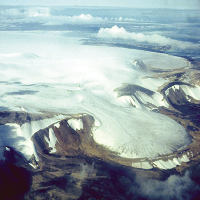16 March 2016
The untold impact on permafrost carbon emissions
The first circumarctic projections of carbon export from rivers and coastal erosion are said to be nearly doubling by 2100 and of tundra fire by 3-fold increase.
The findings further assert that the permafrost zone will be a net carbon source by 2100. However, experts predict 65-85% of carbon release may still be avoided if human emissions start decreasing before 2050.
The permafrost carbon feedback has been portrayed in popular media and to a lesser extent in peer-reviewed literature as an all-or-nothing scenario. Permafrost greenhouse gas release has been described as a tipping point, a runaway climate feedback, and most dramatically, a time bomb. Though models predict that some portion of permafrost carbon release will be offset by increased arctic and boreal biomass, estimates of the permafrost carbon feedback vary by a factor of thirty. This uncertainty means that permafrost carbon is currently not considered in climate negotiations, increasing the risk of further overshooting international emissions targets with serious societal and environmental consequences.
Because precise empirical or model-based assessments of the critical factors driving permafrost carbon balance are unlikely in the near future, we used expert assessment techniques to collect quantitative judgments from 98 permafrost-region scientists of the response of high-latitude carbon balance to four warming scenarios. This approach is complementary to traditional modeling techniques because it allows consideration of a range of factors known to affect carbon balance but insufficiently quantified for inclusion in models. For the permafrost region these effects include nutrient dynamics, non-linear shifts in vegetation, human disturbance, land-water interactions, and the relationship of permafrost degradation with water balance.
Results suggest that, contrary to current model projections, total permafrost-region biomass could decrease due to water stress and disturbance in the boreal forest. Experts predicted major shifts in hydrologic carbon flux and wildfire emissions, particularly for carbon released into the ocean from collapsing coastlines and for tundra fire, which could increase by 2- and 5-fold, respectively, by the end of the century. In combination with previous findings, these results suggest the permafrost region will become a carbon source to the atmosphere by 2100 regardless of warming scenario. However, because estimates of change in biomass are similar across warming scenarios but permafrost carbon release is strongly temperature-sensitive, the emissions gap widens for warmer scenarios, resulting in five-times more net carbon release under the business as usual scenario (RCP8.5) than for the active reduction of human emissions scenario (RCP2.6). This suggests that 65 to 85% of permafrost carbon release can still be avoided if human emissions are rapidly reduced.
Our study does not support a runaway climate feedback scenario, but instead indicates that the strength of the permafrost carbon feedback depends on the amount of human emissions. That said, based on warming events in the Paleozoic and the Holocene when permafrost was completely or partially degraded, there could be a tipping point between 1.8 and 3.7°C of warming (650 and 850 ppm CO2) after which permafrost degradation becomes self-sustaining. What is clear from the spread of expert responses and model simulations is that the rate and magnitude of current warming is taking us into uncharted territory in regards to permafrost carbon.
Press release for Biomass offsets little or none of permafrost carbon release from soils, streams, and wildfire: an expert assessment[1] published in Environmental Research Letters on 7 March 2016.
[1] The article is freely downloadable at the following link: http://dx.doi.org/10.1088/1748-9326/11/3/034014
CONTACT DETAILS
Distinguished Emeritus Research Scholar Agriculture, Forestry, and Ecosystem Services Research Group - Biodiversity and Natural Resources Program
Research Group Leader and Principal Research Scholar Agriculture, Forestry, and Ecosystem Services Research Group - Biodiversity and Natural Resources Program
NEWS
"Climate Modernity" - The 24H Challenge: How do we want to live and act in the future in Styria ?
Health fears can increase pandemic isolation habits in older Europeans
How circular waste management systems can benefit the environment
Launch of the Northern African Applied Systems Analysis Centre
How we measure the effects of methane matters for climate policy


